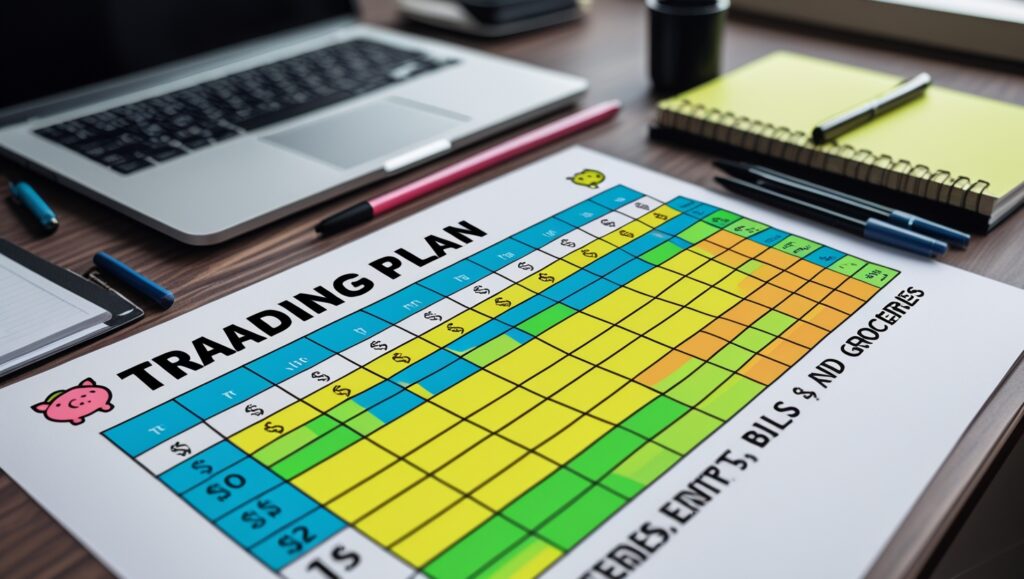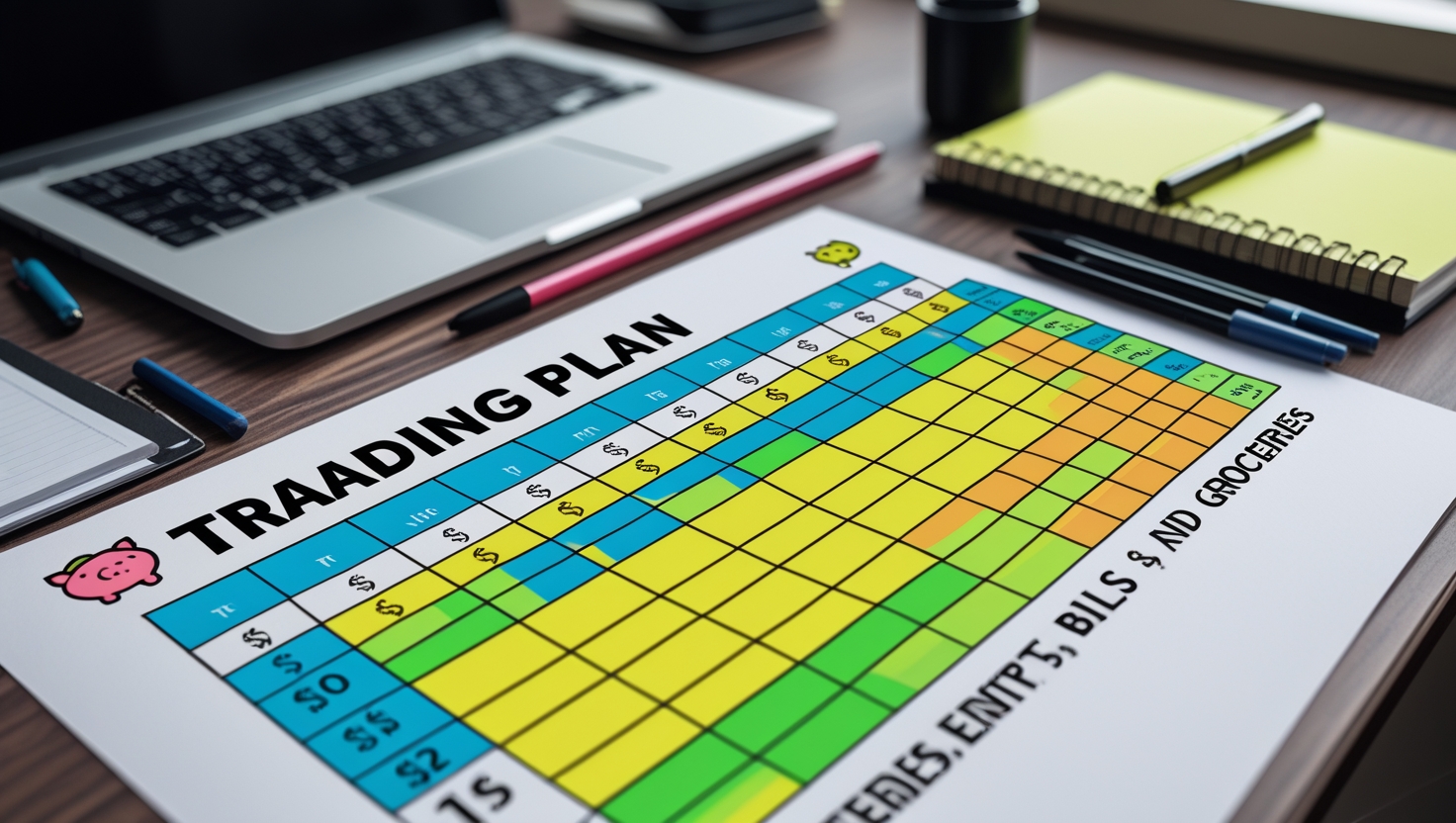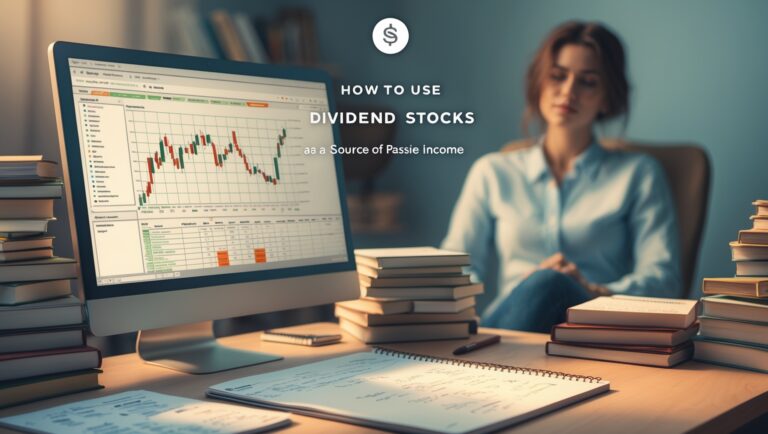The Trading Plan I Follow to Pay Rent, Bills, and Groceries
The Trading Plan I Follow to Pay Rent, Bills, and Groceries
When I tell people I trade stocks to cover my monthly bills — rent, food, utilities — they usually think I’m doing something risky, complicated, or just lucky. But that’s not the case. I’ve built a simple, consistent trading plan that helps me generate real income — month after month.
This isn’t about getting rich overnight. I’m not trying to flip every trade into thousands. I trade to cover real-life expenses, and I do it with discipline, structure, and patience. If you want to see exactly how I built this routine, I break it all down inside my ebook:
👉 Pay Bills With Stocks – Get My Daily Plan Here
Let me walk you through what my trading plan looks like, step by step, and how I use it to create steady cash flow from the market — even with a small account.

Table of Contents
I Trade Only 3–4 Times a Week
This surprises a lot of people, but I don’t trade every day. I wait for clear setups. That means no guessing, no gambling, no chasing. I pick my spots. I’d rather take two solid trades a week than ten random ones.
The goal is consistency, not activity. My trading plan is built around waiting for volume, news catalysts, and price levels to line up. If they don’t, I don’t trade — simple as that.
I Build My Watchlist Before 9:30AM
Every morning, I start by scanning for pre-market movers. I look for stocks with volume over 1M, gapping up with news, and under $30 (ideal for small accounts). I then narrow it down to about 6 stocks and build a basic game plan for each one.
This pre-market routine is the same one I teach inside my ebook. It’s what sets me up to win — because when the bell rings, I already know what I’m looking for.
I Stick to a Simple Setup
My strategy is based on momentum and reaction, not prediction. I wait for stocks to break above a pre-market high or key level with volume. If it confirms, I’m in. If not, I wait.
I don’t use indicators. I read price action, volume, and structure. This clean approach lets me trade fast and confidently — and it works well for small accounts.
I Use Tight Risk Management
To pay my bills, I need to protect my capital. That means I use stop losses, limit orders, and never risk more than I’m comfortable with. Even if I lose one or two trades in a week, one win can cover the loss and still leave profit.
This part is key. I treat trading like a business — not a lottery. I’m here to make consistent withdrawals, not chase once-in-a-lifetime wins.
I Track Every Trade
After each trade, I review what worked and what didn’t. I track the setup, entry, exit, volume, and emotions. This helps me stay sharp and learn from every win and loss.
Most people skip this part — but for me, it’s one of the main reasons I’ve been able to trade for bills, not just for fun. Data keeps me disciplined.
I Withdraw Monthly
At the end of each month, I take a portion of my profits and use it for real-life expenses. Rent, groceries, internet, car insurance — these are the things my trades help cover. It’s not just money on a screen — it’s money that keeps my life running.
There’s something powerful about paying your bills with profits you made by staying focused and sticking to your plan. It’s freedom. And it’s possible.
This Plan Isn’t Complicated — But It’s Real
I didn’t invent some secret strategy. I didn’t get lucky. I built a plan that works for me, and I show exactly how I do it in my ebook.
It’s written for beginners, small account traders, or anyone tired of watching YouTube videos with no real structure. Inside, I walk through:
- How I build my morning watchlist
- What I look for in stocks
- How I trade without indicators
- My risk management process
- How I’ve created a real routine that helps me pay bills
Final Thoughts
If you’re serious about trading but overwhelmed by noise, try simplifying. Focus on one repeatable setup, track it, and build a routine that supports your goals — whether that’s rent, groceries, or just extra income.
That’s exactly what I’ve done. And if you want a shortcut to avoid months of trial and error,
👉 grab my ebook here
This is the real plan I use — and if I can make it work, so can you.
One of the most important shifts I made early on was learning to treat this like a job, not a side hustle. I wake up with intention. My mindset isn’t “let’s see what happens today.” It’s “how do I follow my plan today and protect my capital?” That alone changed everything.
I also stopped chasing alerts. I used to follow random calls on Twitter or Discord hoping for fast profits. But all it did was cost me money and time. Now I rely on my own watchlist — built with volume, catalysts, and key levels I understand. I don’t need anyone else’s trades.
Another thing that helped me was trading only the open. Most of my trades happen within the first 60 minutes of the market. That’s when volume is highest and momentum is cleanest. After that, I usually step away. Trading less actually helped me earn more.
There’s a myth that you need a huge account to see results. That’s false. With the right structure, even a small trading account can bring in enough to pay real bills. I started small — I had no choice — but with smart setups, it grew faster than I expected.
I don’t swing for home runs. I focus on base hits. If I can make a few hundred dollars per week with consistency, that’s real progress. Those small wins stack up. I talk more about this mindset in my ebook because most beginners overlook it — but it’s critical.
The psychology of trading plays a huge role too. I’ve learned to wait. I don’t take trades out of boredom. I don’t force anything. I trust my prep, and if nothing meets my criteria, I don’t touch the market. That discipline keeps me profitable.
I also rotate between sectors based on what’s hot. If biotech is running this week, that’s where I look. If AI or EVs are showing volume, I shift focus. Staying aligned with the market’s current narrative gives me an edge without needing complex tools.
One thing I always do is respect my stop. No matter how “good” a trade looks, if it breaks my level, I’m out. No questions asked. This rule protects my account and keeps my head clear for the next opportunity.
When I review my trades, I always ask: Did I follow my plan? That’s more important than whether I made money or not. Because if I stick to the plan long enough, the results always come. That’s something I teach inside my ebook — how to stay accountable and sharp over time.
Trading is not magic. It’s structure, patience, and execution. Most people fail not because they don’t know what to do — but because they don’t stick to one thing long enough. My plan gives me clarity, so I’m not jumping between strategies every week.
Every trader hits losses. The difference is how you respond. I don’t chase losses. I don’t double down. I reset, I reflect, and I move on. That emotional control is something I had to develop — and it’s just as valuable as knowing which stock to buy.
If you’re trying to build income from stocks, not just side profits, my trading plan can help you get there. It’s not based on luck or hype — it’s built from real practice, and it’s available right now:
👉 Download the ebook here

Stay ahead in the stock market! Subscribe to our newsletter and receive exclusive stock flow reports, trading insights, and actionable tips directly in your inbox. Join thousands of traders who get our updates first.








10 Comments